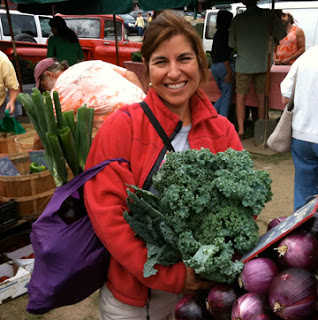As I mentioned, I’m attending the annual BlogHer Food conference this weekend, which is so conveniently located in my home city this year (which means I get to sleep in my own bed…yay!). I had an opportunity yesterday to talk with one of today’s conference keynote speakers, Terry Walters. Terry is the author of two cookbooks, Clean Food and Clean Start. (You can find a few recipes from Clean Start on her website. I’m looking forward to making the Shallot Fig Spread, personally.)
 |
| Photo: TerryWalters.net |
Terry’s a woman after my own heart, encouraging eaters to move away from processed foods and toward real, whole foods that, when possible, are local, organic and in-season. But she also has a few tricks up her sleeve that I don’t have, so I knew immediately what I wanted to ask her.
First, I asked for her take on how someone who is eating the Standard American Diet can start taking first steps toward eating a “cleaner” diet. She suggested starting with adding new vegetables, fruits and other healthful foods, rather than subtracting old less-than-healthful foods.
“You can look at what you’re eating and fill in with the colors that you’re missing. Focusing on getting good foods in instead of depriving yourself, because depriving always backfires.”
“If you bring in one cool new food every week, even if you only like half of them, at the end of the year you’ll have 26 new foods.” She said that most people do best with slower changes, because tastebuds may be slow to change when introducing newer, healthier foods. That’s followed, also slowly, by awareness of positive changes in how you feel.
Terry said it’s important to move our food choices closer to the source (i.e., whole and minimally processed foods), but that the process of making that change will look different for each person. For one person, it may mean getting artificial ingredients out of their foods. For another, it may mean working toward cutting out processed foods altogether. For another, it may mean shifting from buying food from a supermarket to buying it from local farmers.
Because I’m always interested in “healthiest foods” lists (and I bet you are, too), I asked Terry for some of her top picks for nutrient-packed foods.
- Kale.* She said most people could use more vitamin- and mineral-packed dark leafy greens in their diet (which I wholeheartedly agree with).
- Quinoa. It’s a non-gluten, high-protein grain that is quick cooking (takes about 15 minutes) and can help improve the complex carbohydrate profile of our diets. She pointed out that it’s not a heavy grain, which makes it a great choice for warmer weather menus.
- Berries. Rich in antioxidants, and an all-around super-nutritious fruit.
- Coconut oil. A great healthy fat that she likes to use for baking and sauteeing.
She called out daily smoothies as “a great place for throwing in all those super nutritionals.” Berries. Kale. Maybe a few nuts for protein and healthy fats. Maybe a little coconut water. Delicious.
Because Terry is clearly a skillful user of sea vegetables (or seaweed, if you will), whereas my fledgling attempts to use these mineral-rich plants in my diet have been hit-or-miss, I made sure to ask her opinion on the best way for a sea veggie newbie to start broadening their horizons.
Start with arame, she said. “It’s the entry-level sea vegetable.”
Why? Because it has a mild flavor, a beautiful color, and it’s fine dried shreds reconstitute in just a few minutes in a bowl of water on the kitchen counter. She suggested tossing it on salads or grain dishes to add nutrition and color without significantly altering the taste of the dish.
Sold! Next?
Sheets of dried nori are great for crinkling on top of salads or using as wraps around just about anything, she said. Even leftovers. One delicious-sounding combination, which she said is a hit with her kids, is rice, avocado, pickled ginger and mango.
She did suggest toasting nori sheets before using (unless you buy nori that’s pre-toasted), because untoasted nori can taste a bit too “bottom of the sea” for some people. (I became curious about how to toast nori later, and found this tutorial.)
A new edition of Clean Food is coming out this fall. It includes a whole new section on healthy snacks–handy with so many families on the go.As with the first edition, the recipes are vegan…but not just for vegans. “These are foods that everyone benefits from having more of,” she said. What’s different about the new edition is that the recipes have been modified so that they are gluten free. Terry also removed agave nectar (replacing it with maple syrup) and canola oil. Agave has become a controversial sweetener, a controversy that arose, ironically, right about the time the first edition of her book was released.
Even though maple syrup is one of the healthiest sweetener choices (and I’m jealous that she has a “maple syrup guy”), she points out that one of the benefits of eating unprocessed foods is that you come to realize that there is a satisfying natural sweetness in many foods. Again, these changes in awareness may take time, but that’s OK.
“Don’t judge yourself,” she said. “Across the board, we’re all empowered by knowledge. Take it one choice at a time.”
* I mentioned my “Eat More Kale” T-shirt, and it turns out she’s an early adopter from several years ago. She’s from the Northeast, and she happened to see Bo driving around with an “Eat More Kale” bumper sticker and asked him if he had T-shirts,which he didn’t…yet. Awesome!






